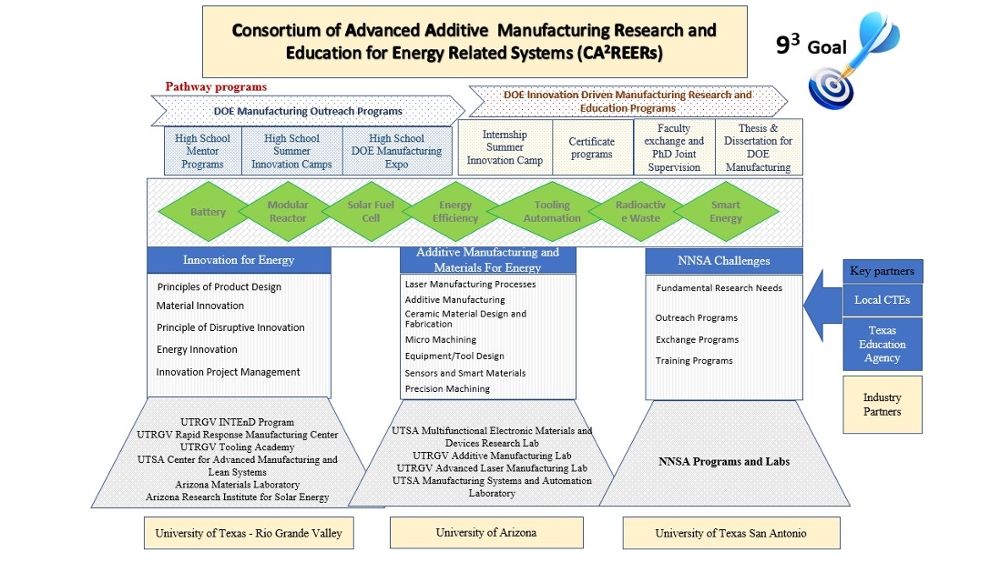About Us
Consortium of Advanced Additive Manufacturing Research and Education for Energy Related Systems.
The goal of this project is to develop and sustain the DOE Consortium of Advanced Additive Manufacturing Research and Education for Energy Related Systems to expose, recruit, engage and train students for a career in Advanced Manufacturing for Energy, following a collaborative approach by a team of investigators from institutions and 2 DOE Labs. The education institutions include University of Texas Rio Grande Valley, University Texas San Antonio, and University of Arizona. The DOE/NNSA labs are Oak Ridge National Lab and Los Alamos National Lab. The consortium, with a total student enrollment of around 100,000(UTRGV 27,708, UTSA 32,101, and University of Arizona 44,831). The long-term vision of the consortium is to cultivate an innovation driven manufacturing education ecosystem for Energy Innovation with programs designed to recruit young talents and prepare them with solid education and real-life experiences in energy innovation and advanced manufacturing technologies. Upon graduation, students are ready for a dream career in DOE/NNSA labs and energy industries.
The proposed DOE CA2REERsconsortium prepares future STEM talents through the following talent preparation programs:
A: DOE Energy innovation Expo and Conference: The consortium plans to organize annual high school and expo and demonstration conferences each year during the four-year period, at each participating site. These expo events will be supported by DOE/NNSA scientists, researchers at the institutions, and students engaged in the research projects. Participants will be exposed to exciting innovation and career opportunities in the Energy fields and DOE/NNSA labs. These efforts will be focused on attracting high caliber students at the target high schools to an Energy filed career.
B: Summer Manufacturing Innovation Camp for High School Students: The consortium will organize 2-week energy innovation high school summer camps at three sites and cultivate interest for high school students in advanced manufacturing technologies that support energy innovation.
C: Energy Manufacturing Summer Internship and Experiential Programs for graduate and undergraduate students at DOE and NNSA Labs.
D: Energy Innovation Certificate at Graduate level and Curriculum Enhancement programs at undergraduate level across all three participating institutions. One important focus of the consortium is to link DOE/NNSA research and innovation to classroom teaching, with a goal to prepare future talents with both domain specific and multidisciplinary knowledge required in Energy Related Systems while focusing on advanced manufacturing science and technologies. This proposed grant will help bring researchers and scientists from DOE/NNSA labs to 3 institutions in both teaching and student supervision. This will be further enriched by an Energy Innovation Competition event involving all institutions.
E: Faculty and Student Exchange program across the consortium members. The team has a history of conducting collaborative research/education among themselves and with ORNL and LANL lab scientists. The consortium will continue to facilitate and support faculty/scientist exchange with the Labs and further strengthen student exchange through current articulation agreement between UTSA and UTRGV, and future agreement with University of Arizona. This exchange program is critical, as the energy innovation projects required multidisciplinary knowledge and takes a collaborative approach to engage and train student in these projects.
F: Research Experiences for Undergraduate and Graduate students to engage high caliber students at undergraduate and postgraduate levels in fascinating innovation and research projects. These projects will be categorized in four thrusts which require a collaborative approach leveraging research expertise of 2 team in advanced additive manufacturing, materials for extreme conditions, and energy systems. These research/innovation projects will be directed by a collaborative team composed by participating faculties and lab scientists from DOE Labs. Through the joint supervision and engagement for the students at both academic sites and DOE labs, future scientists and leaders of energy production will be educated and prepared.
The 9 3 goal: The proposed DoE CA2REERs consortium leverages well designed and planned exposure, engagement, education, research programs at three higher education institutions. With collaboration of community colleges, local school districts, and DOE/NNSA labs, these programs are aligned with a talent preparation pipeline to cultivate interests in advanced manufacturing for energy innovation and to recruit and prepare talent for CAREERs in national labs and the energy industry. Specifically, The CA2REERs consortium has a 9 3 goal: 1) Expose career opportunities in Energy and National Labs to at least 9000 high school students, 2) Attracts and engage at least 900 college students in the Energy Innovation Competition programs and the Advanced Manufacturing for Energy Innovation certificate program, 3)Recruit and engage at least 90 high caliber undergraduate and graduate students in the proposed research programs, and train them in areas critical to DOE/NNSA’s missions. The proposed work is also measured by the number and quality of innovation projects, the teaching and training materials created, the students qualified and eventually hired for internship at DOE/NNSA facilities, during the 4-year period.

